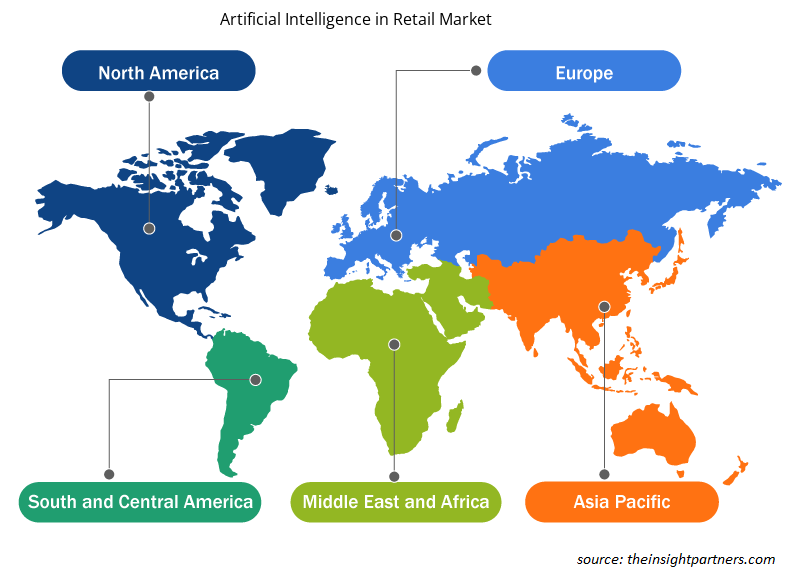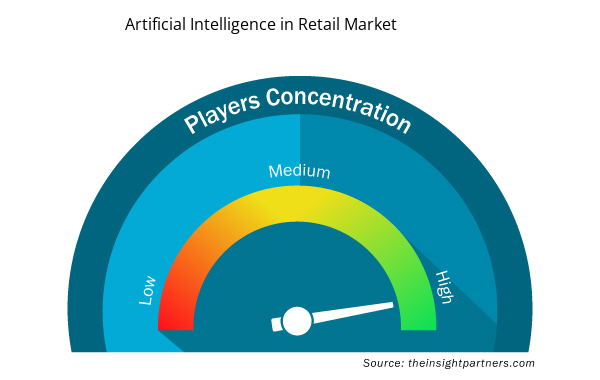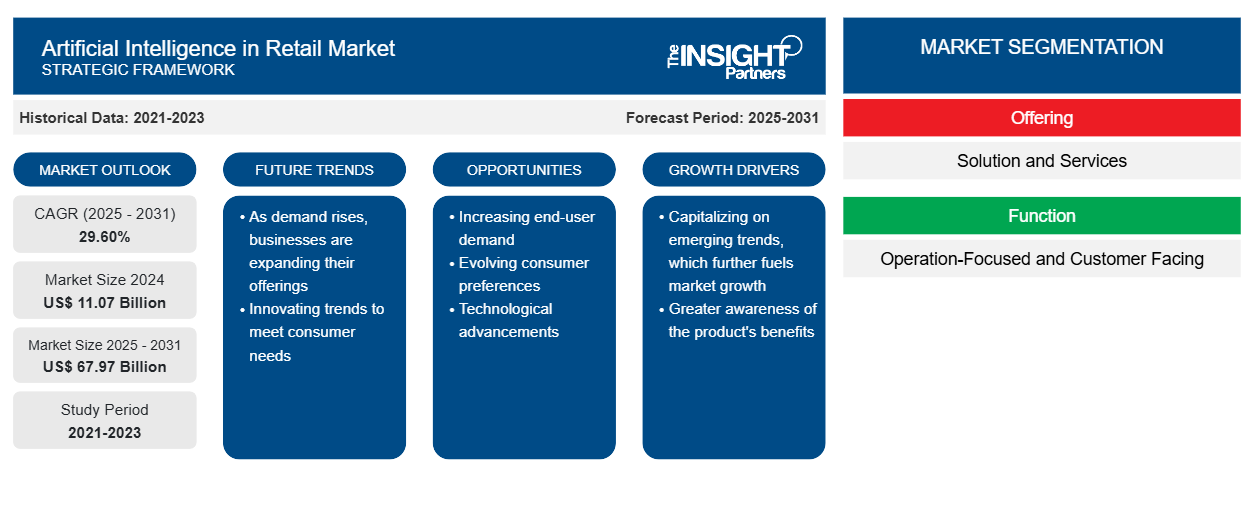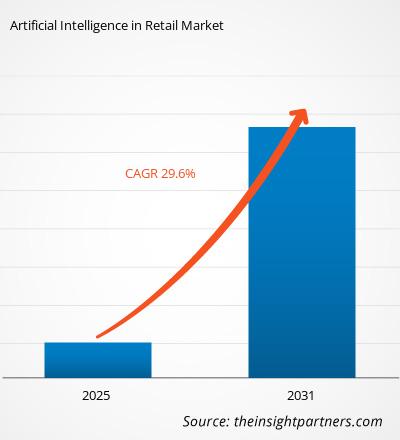[調査レポート] 小売市場における人工知能の市場規模は、2022年の65億9,000万米ドルから2031年には524億5,000万米ドルに成長すると予想されており、2022年から2031年にかけて29.6%のCAGRで成長すると予測されています。
アナリストの視点:
小売業界は、人工知能 (AI) の結果として変化しています。小売業者は、コンピューター ビジョンを利用してプロモーションをリアルタイムで変更したり、機械学習を利用して在庫管理を行ったりするなど、人工知能 (AI) を使用して顧客と関わり、ビジネスをより効率的に運営することができます。現在のグローバル市場で競争したい小売企業にとって、利益と生産性は最優先事項でなければなりません。成功を確実にし、競合他社より優位に立つためには、迅速かつ効果的な行動が必要です。 人工知能 (AI) は、収益を増やし、管理手順を合理化することで、小売業務を強化できます。AI は、企業が人件費と供給コストを節約し、在庫切れを回避し、売上を伸ばす「スマートな」人員配置と補充の選択を採用する道を開きます。AI の結果として小売業の立場は変化し、企業の効率が向上します。小売企業は、テクノロジーの発展に伴い、人工知能が業界をどのように変えているのかを知ることに、より関心を持っています。
たとえば、全米小売業協会の2023年の報告書によると、最近、リーバイ・ストラウス社はカスタマイズされたAIによって作成されたモデルを使用すると発表しました。プーマとアメリカンイーグルは、それぞれ在庫追跡とカスタマイズされた消費者スタイリングにAIを採用していると主張しました。リーバイは、より多様な体型を提供するために、モデルを支援するためにAIを使用する予定です。同社はNRFに、今年後半にAI生成モデルを使用してLevi.comで「限定的で規制された」プロジェクトを調査することを通知し、「より多くのことを学び、全体的な消費者体験を改善できるかどうかを確認する」と述べました。また、同協会は、小売業者の約60〜70%がサプライチェーン内の商品の場所を把握しておらず、店舗間を移動する商品を追跡できないと述べています。最も技術的に熟練した組織でさえ、依然として非常に多くの課題を抱えています。これは、小売市場における人工知能の応用の可能性を示しています。
小売市場における人工知能の概要:
小売業界は、消費者の需要と技術の進歩に応じて絶えず変化しています。小売業界が実店舗から電子商取引、オムニチャネルへと移行する中、人工知能は、需要予測や推奨など、さまざまな方法で小売業者の業務改善を支援しています。小売業界全体で AI が広く使用されている主な例としては、需要予測、推奨、レジなし技術、在庫管理、顧客感情分析などがあります。小売業者は、コスト管理と顧客が製品とどのようにやり取りするかを理解することで優位に立つために、AI にますます注目しています。需要予測は、小売業界で最も頻繁に使用される AI の用途の 1 つです。サプライ チェーンを管理し、在庫レベルを最適化し、値下げを防ぐために、小売業者はまず、どの顧客が特定の製品をどこで望んでいるかを理解する必要があります。たとえば、ナイキは 2021 年に AI スタートアップの Celect に 1 億 1,000 万ドルを費やし、消費者の需要をリアルタイムでより適切に分析し、必要な物資を配置できるようにしました。
ブランドは、カスタマイズを通じて、あらゆる購入取引を関連性のある楽しいものにすることができます。実際、今日の小売環境では、パーソナライズされたショッピング体験は、顧客エンゲージメント、維持、ロイヤルティにとって非常に重要です。AI は、顧客が正しい購入を繰り返し行ったと満足できるスムーズな体験を提供するため、パーソナライズはコンバージョン率と製品売上の向上にもつながります。たとえば、Salesforce 2016 レポートによると、企業が顧客とのコミュニケーションをパーソナライズしない場合、顧客の 52% がブランドを変更する可能性があります。現在接続されている顧客は、より迅速な小売の更新を期待しています。実際、消費者の 69% は、対面で買い物をするかオンラインで買い物をするかに関係なく、新しい製品を見つけることを期待していると述べています。顧客がオンラインビジネスにアクセスするたびに、人工知能が閲覧履歴を分析し、新しい製品オプションを自動的に提供できます。これにより、消費者が同じ製品を見ることに飽きることがなくなり、特にモバイルデバイスで衝動買いを誘発するのに役立ちます。
要件に合わせてレポートをカスタマイズする
このレポートの一部、国レベルの分析、Excelデータパックなど、あらゆるレポートを無料でカスタマイズできます。また、スタートアップや大学向けのお得なオファーや割引もご利用いただけます。
- このレポートの主要な市場動向を入手してください。この無料サンプルには、市場動向から見積もりや予測に至るまでのデータ分析が含まれます。
小売市場における人工知能の推進力:
パーソナライズされたショッピングへの嗜好の高まりが小売市場における人工知能の成長を促進
消費者は AI から利益を得ています。 チャットボットは、買い物客が店内を素早くナビゲートし、カスタマイズされた製品の推奨を受けるのに役立ちます。小売業者は、業界で AI 技術がますます普及しているおかげで、顧客と対話し、業務を合理化し、売上を伸ばすための新しい創造的な方法を手に入れました。需要を推定し、在庫レベルを管理するために、アルゴリズムは過去の販売データ、気象パターン、ソーシャル メディアの傾向などの要素を調べる場合があります。全体として、この研究は、小売業者が無駄を削減し、在庫の問題を回避し、利益を増やすのに役立ちます。小売業者は、購入履歴や閲覧習慣などの顧客データを AI を使用して評価することにより、ターゲットを絞ったカスタマイズされたマーケティング メッセージを送信できます。これにより、マーケティング コミュニケーションがより適切になるだけでなく、顧客エクスペリエンス全体を向上させることもできます。消費者向けの小売市場における人工知能の最も重要な用途の 1 つは、カスタマイズされたマーケティングの能力です。小売業界では、パーソナライゼーションが重要な成功要因として浮上しています。たとえば、小売業者は、AI を活用したデジタル マーチャンダイジングおよびスタイリング ソリューションのトップ プロバイダーである Stylitics によって、この困難を克服し、最先端を維持するための支援を受けています。Stylitics プラットフォームは、消費者データと機械学習アルゴリズムを使用して、高度にカスタマイズされた提案を顧客に提供します。毎年 500 億回を超えるショッピング セッションで、このシステムは服装やバンドルの推奨を行っており、2022 年までに消費者の収入が 40 億米ドル以上増加し、さらに 2 億個の商品が販売されることになります。
小売市場のセグメント分析における人工知能:
アプリケーションに基づいて、小売市場における人工知能は、予測分析、店内視覚監視と監視、顧客関係管理、市場予測、在庫管理などに分類されます。在庫管理は市場で大きなシェアを占めており、最も高い成長率で成長しています。人工知能は在庫追跡と管理プロセスを自動化できるため、小売業者は最適な在庫を維持できます。これが主にセグメントの成長を促進しています。AIツールは、在庫の計画、在庫、配送の成功に影響を与えるすべての内部および外部要因を分析することもできます。最終結果は在庫管理エラーの減少であり、企業の経費削減と顧客満足度の向上に役立ちます。ロボットはデータを評価し、需要動向を予測できるため、運用面でもより効果的です。また、各アクションに費やす時間の点で効率が高く、人為的ミスの可能性を排除します。AI駆動型ロボットは、財務の観点から人間の労働よりも運用コストが低くなります。毎月の給与と福利厚生を要求する人間の従業員とは異なり、これらのマシンには、1回限りの取得料金と定期的なメンテナンス料金のみが必要です。たとえば、2021年のMITテクノロジレビューの記事によると、ナップは保管業務に約2,000台のAI搭載ロボットを導入している。また、2023年にはウォルマートが2番目のマーケットフルフィルメントセンター(MFC)を立ち上げた。これは、オンライン食料品配達用に購入された商品を自律型カートで取りに行くアルファボットを活用したカスタム保管・回収システムで運営されている。
小売市場における人工知能の地域分析:
北米地域では、米国はさまざまな分野のビジネスアプリケーション向けの小売技術における人工知能の開発に多額の投資を行っています。この地域には、ウォルマートやアマゾンなど、世界の主要な小売企業が集まっています。これらのトップ小売企業は、ビジネスをシームレスにするために、小売技術における革新的な人工知能の導入の最前線に立っています。たとえば、2022年11月には、アマゾンの最新のインテリジェントロボットデバイスであるSparrowが発表されました。アマゾンによると、Sparrowは、包装される前に個々の製品を移動することで、フルフィルメントプロセスをスピードアップします。アマゾンによると、Sparrowは、在庫から特定のアイテムを認識、選択、および処理できる倉庫初のロボットです。メーカーによると、Sparrowは、コンピュータービジョンと人工知能(AI)を利用して何百万もの製品を認識および管理する、産業用ロボットの最先端技術の大幅な改善です。
小売市場における人工知能の地域分析
予測期間を通じて小売市場における人工知能に影響を与える地域的な傾向と要因は、Insight Partners のアナリストによって徹底的に説明されています。このセクションでは、北米、ヨーロッパ、アジア太平洋、中東、アフリカ、南米、中米にわたる小売市場における人工知能のセグメントと地理についても説明します。

- 小売市場における人工知能の地域別データを入手
小売市場における人工知能レポートの範囲
| レポート属性 | 詳細 |
|---|---|
| 2023年の市場規模 | 85億4千万米ドル |
| 2031年までの市場規模 | 679.7億米ドル |
| 世界のCAGR(2023年~2031年) | 29.60% |
| 履歴データ | 2021-2022 |
| 予測期間 | 2024-2031 |
| 対象セグメント | 提供することで
|
| 対象地域と国 | 北米
|
| 市場リーダーと主要企業プロフィール |
|
市場プレーヤーの密度:ビジネスダイナミクスへの影響を理解する
小売市場における人工知能市場は、消費者の嗜好の変化、技術の進歩、製品の利点に対する認識の高まりなどの要因により、エンドユーザーの需要が高まり、急速に成長しています。需要が高まるにつれて、企業は提供を拡大し、消費者のニーズを満たすために革新し、新たなトレンドを活用し、市場の成長をさらに促進しています。
市場プレーヤー密度とは、特定の市場または業界内で活動している企業または会社の分布を指します。これは、特定の市場スペースに、その市場規模または総市場価値に対してどれだけの競合相手 (市場プレーヤー) が存在するかを示します。
小売市場における人工知能で事業を展開している主要企業は次のとおりです。
- センティエント・テクノロジーズ・ホールディングス
- マンサン ソフトウェア サービス株式会社株式会社
- フォーカルシステムズ株式会社
- マイクロソフト株式会社
- ヴィセンゼ
免責事項:上記の企業は、特定の順序でランク付けされていません。

- 小売市場における人工知能のトップキープレーヤーの概要を入手
小売市場における人工知能の主要プレーヤー分析:
小売市場における人工知能の分析には、DataRobot、Inc.、IBM、OpenAI、Microsoft、Amazon、Google、Dataiku、Salesforce、Baidu、SAP などの企業が含まれており、レポートで紹介されている小売市場における主要な人工知能の企業の一部です。
小売市場における人工知能の最新動向:
小売市場における人工知能では、合併や買収などの無機的および有機的な戦略が企業に広く採用されています。最近の主要な市場動向をいくつか以下に示します。
- 2023 年 9 月、Amazon は小売市場に生成型人工知能を導入し、ベンダーの商品説明作成を支援します。Amazon の販売者は、新しい生成型 AI 機能セットのおかげで、より詳細で興味深い商品説明、名前、出品機能を簡単に作成できるようになります。これらの新機能の追加により、ベンダーは新製品をより迅速かつ簡単に出品し、現在の出品を強化することができるため、購入者は購入時に安心できます。
- 2023 年 6 月、カルフールは ChatGPT テクノロジーに基づく 3 つの最先端のテクノロジー ソリューションを実装します。carrefour.fr のショッピング アシスタント ロボット、ウェブサイト上のカルフール ブランド製品の製品説明シート、購入プロセスの支援です。OpenAI、特に GPT-4 の背後にあるテクノロジーが、これらのソリューションの基盤を構成しています。
- 2023 年 6 月、マイクロソフトは、顧客が「自信を持って」買い物をしてお金を節約できるようにする、人工知能 (AI) を搭載した新しい Bing および Edge ショッピング機能を発表しました。AI の力を活用した新しい機能は、ユーザーが情報を見つけ、調査を行い、購入を完了するのをすべて 1 つの便利な場所で支援します。
- 2023 年 1 月、顧客によりシームレスなオンライン ショッピング体験を提供し、販売者が店舗内の在庫を管理できるようにするために、Google Cloud は 4 つの新しい AI 機能とアップグレードされた AI 機能をリリースします。
- 過去2年間の分析、基準年、CAGRによる予測(7年間)
- PEST分析とSWOT分析
- 市場規模価値/数量 - 世界、地域、国
- 業界と競争環境
- Excel データセット



Report Coverage
Revenue forecast, Company Analysis, Industry landscape, Growth factors, and Trends

Segment Covered
This text is related
to segments covered.

Regional Scope
North America, Europe, Asia Pacific, Middle East & Africa, South & Central America

Country Scope
This text is related
to country scope.
Trends and growth analysis reports related to Technology, Media and Telecommunications : READ MORE..
The List of companies
1. Sentient Technologies Holdings Limited
2. Manthan Software Services Pvt. Ltd
3. Focal Systems Inc
4. Microsoft Corporation
5. ViSenze
6. Tata Consultancy Services Limited
7. Salesforce.com, Inc
8. Plexure Ltd.
9. Google,Inc
10. IBM Watson Group
The Insight Partners performs research in 4 major stages: Data Collection & Secondary Research, Primary Research, Data Analysis and Data Triangulation & Final Review.
- Data Collection and Secondary Research:
As a market research and consulting firm operating from a decade, we have published and advised several client across the globe. First step for any study will start with an assessment of currently available data and insights from existing reports. Further, historical and current market information is collected from Investor Presentations, Annual Reports, SEC Filings, etc., and other information related to company’s performance and market positioning are gathered from Paid Databases (Factiva, Hoovers, and Reuters) and various other publications available in public domain.
Several associations trade associates, technical forums, institutes, societies and organization are accessed to gain technical as well as market related insights through their publications such as research papers, blogs and press releases related to the studies are referred to get cues about the market. Further, white papers, journals, magazines, and other news articles published in last 3 years are scrutinized and analyzed to understand the current market trends.
- Primary Research:
The primarily interview analysis comprise of data obtained from industry participants interview and answers to survey questions gathered by in-house primary team.
For primary research, interviews are conducted with industry experts/CEOs/Marketing Managers/VPs/Subject Matter Experts from both demand and supply side to get a 360-degree view of the market. The primary team conducts several interviews based on the complexity of the markets to understand the various market trends and dynamics which makes research more credible and precise.
A typical research interview fulfils the following functions:
- Provides first-hand information on the market size, market trends, growth trends, competitive landscape, and outlook
- Validates and strengthens in-house secondary research findings
- Develops the analysis team’s expertise and market understanding
Primary research involves email interactions and telephone interviews for each market, category, segment, and sub-segment across geographies. The participants who typically take part in such a process include, but are not limited to:
- Industry participants: VPs, business development managers, market intelligence managers and national sales managers
- Outside experts: Valuation experts, research analysts and key opinion leaders specializing in the electronics and semiconductor industry.
Below is the breakup of our primary respondents by company, designation, and region:

Once we receive the confirmation from primary research sources or primary respondents, we finalize the base year market estimation and forecast the data as per the macroeconomic and microeconomic factors assessed during data collection.
- Data Analysis:
Once data is validated through both secondary as well as primary respondents, we finalize the market estimations by hypothesis formulation and factor analysis at regional and country level.
- Macro-Economic Factor Analysis:
We analyse macroeconomic indicators such the gross domestic product (GDP), increase in the demand for goods and services across industries, technological advancement, regional economic growth, governmental policies, the influence of COVID-19, PEST analysis, and other aspects. This analysis aids in setting benchmarks for various nations/regions and approximating market splits. Additionally, the general trend of the aforementioned components aid in determining the market's development possibilities.
- Country Level Data:
Various factors that are especially aligned to the country are taken into account to determine the market size for a certain area and country, including the presence of vendors, such as headquarters and offices, the country's GDP, demand patterns, and industry growth. To comprehend the market dynamics for the nation, a number of growth variables, inhibitors, application areas, and current market trends are researched. The aforementioned elements aid in determining the country's overall market's growth potential.
- Company Profile:
The “Table of Contents” is formulated by listing and analyzing more than 25 - 30 companies operating in the market ecosystem across geographies. However, we profile only 10 companies as a standard practice in our syndicate reports. These 10 companies comprise leading, emerging, and regional players. Nonetheless, our analysis is not restricted to the 10 listed companies, we also analyze other companies present in the market to develop a holistic view and understand the prevailing trends. The “Company Profiles” section in the report covers key facts, business description, products & services, financial information, SWOT analysis, and key developments. The financial information presented is extracted from the annual reports and official documents of the publicly listed companies. Upon collecting the information for the sections of respective companies, we verify them via various primary sources and then compile the data in respective company profiles. The company level information helps us in deriving the base number as well as in forecasting the market size.
- Developing Base Number:
Aggregation of sales statistics (2020-2022) and macro-economic factor, and other secondary and primary research insights are utilized to arrive at base number and related market shares for 2022. The data gaps are identified in this step and relevant market data is analyzed, collected from paid primary interviews or databases. On finalizing the base year market size, forecasts are developed on the basis of macro-economic, industry and market growth factors and company level analysis.
- Data Triangulation and Final Review:
The market findings and base year market size calculations are validated from supply as well as demand side. Demand side validations are based on macro-economic factor analysis and benchmarks for respective regions and countries. In case of supply side validations, revenues of major companies are estimated (in case not available) based on industry benchmark, approximate number of employees, product portfolio, and primary interviews revenues are gathered. Further revenue from target product/service segment is assessed to avoid overshooting of market statistics. In case of heavy deviations between supply and demand side values, all thes steps are repeated to achieve synchronization.
We follow an iterative model, wherein we share our research findings with Subject Matter Experts (SME’s) and Key Opinion Leaders (KOLs) until consensus view of the market is not formulated – this model negates any drastic deviation in the opinions of experts. Only validated and universally acceptable research findings are quoted in our reports.
We have important check points that we use to validate our research findings – which we call – data triangulation, where we validate the information, we generate from secondary sources with primary interviews and then we re-validate with our internal data bases and Subject matter experts. This comprehensive model enables us to deliver high quality, reliable data in shortest possible time.


 このレポートの無料サンプルを入手する
このレポートの無料サンプルを入手する